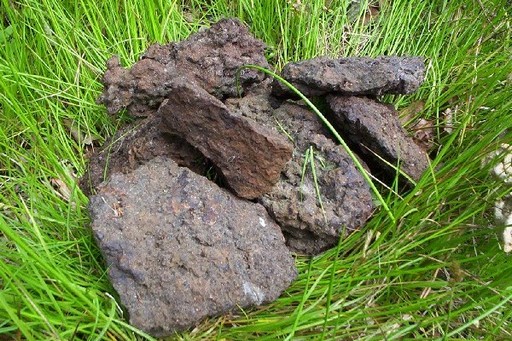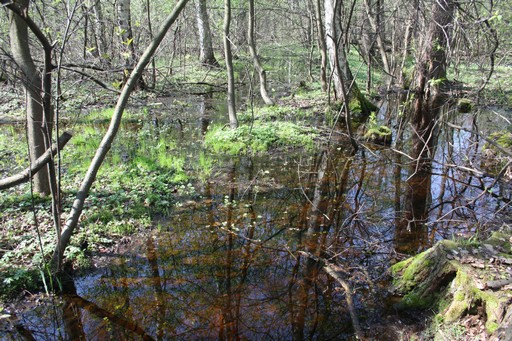
Ruda darniowa / Bog ore
 Ruda darniowa
Ruda darniowa
Ruda darniowa, to ruda zelaza o niewielkiej zawartosci Fe (do 30%). Tam gdzie sa wody z duza iloscia rozpuszczonego w nich zelaza (poznamy je po brazowym zabarwieniu), na podmoklych lakach, lasach, tuz pod ziemia powstaja poklady rudy darniowej. Co ciekawe, sa to zloza odnawialne, jesli teren nie zostanie zdewastowany, to czasem juz po kilku latach nadaje sie ponownie do eksploatacji. W Polsce ruda darniowa wystepuje dosyc powszechnie. Mieszkancy Zyrardowa nie powinni sie dziwic, ze obok w lesie sa jej zloza. Osada fabryczna, pózniejsze miasto Zyrardów powstalo bowiem na terenie wsi Ruda Guzowska. W lesie znajduja sie ujecia wody dla miasta, która przed oddaniem do uzytku nowej stacji uzdatniania, byla bardzo zazelaziona i powszechne byly rude zacieki przy kranach.
Ze wzgledu na niska zawartosc zelaza i charakter zlóz (cienka warstwa), ruda darniowa nie jest uzywana wspólczesnie do przemyslowego wytopu zelaza, ale ze wzgledu na powszechnosc i latwa dostepnosc, byla uzywana od poczatku hutnictwa na naszych ziemiach, az do XX wieku, chocby na mala skale przy dworach. Natomiast ze wzgledu na swa porowatosc i wlasciwosci sorpcyjne, bywa stosowana jako pochlaniacz w filtrach. Mozna tez ja spotkac zastosowana jako budulec.
Ciekawostka jest to, ze tu na Mazowszu Zachodnim powstal jeden z dwóch najwiekszych osrodków hutniczych w barbarzynskiej Europie (drugi, wiekszy byl w Górach Swietokrzyskich). W okresie do I do IV w.n.e. w tysiacach prymitywnych dymarek wytopiono ok. 3 000 ton zelaza! Surowcem byla oczywiscie miejscowa ruda darniowa. Znaczna czesc tego zelaza, prawdopodobnie posluzyla do produkcji broni, wiedzac ze do wytworzenia miecza potrzeba bylo ok. 1kg zelaza, mozna sobie wyobrazic jak wielka armie mozna bylo uzbroic. To osrodek mazowiecki i swietokrzyski uzbroily barbarzynców, które potem wyruszyly na podbój Imperium Rzymskiego. Wraz z upadkiem Rzymu, gdy plemiona germanskie przeniesli sie na zachód i poludnie, konczy sie masowa produkcja zelaza na tych ziemiach.
Miejsce na ukrycie skrzynki nie wybralem przypadkowo, tutaj bowiem znalazlem mój pierwszy kawalek rudy darniowej. Po przeprowadzonej scince, lesnicy zaorali pod uprawy lesne teren przy strumyczku i kawalki rudy walaly sie na powierzchni. Teraz jest tu podmokla laka, czesciowo porosla krzakami, ale jesli pójdziecie na pólnoc wzdluz strumyczka, zobaczycie jak ten teren wygladal przed scinka.
Skrzynka ukryta w korzeniach jednego z drzew, w srodku specjalne certyfikaty (na razie 10, jak sie skoncza, to podskocze dolozyc), po jednym dla kazdego geocachera, nie musisz nic wkladac w zamian :-)
Ciekawe linki:
- artykul Zelazne Laki - Wiedza i Zycie nr 5/2001
- Mazowieckie Centrum Metalurgiczne - muzeum w Pruszkowie

Tak moze wygladac miejsce, gdzie powstaje zloze rudy darniowej
That's how might look place, where bog ore deposit is formed
 Bog Ore
Bog Ore
Bog ore is the iron ore with low Fe content (30%). Bog ore deposits are formed under ground in wet meadows, and forests, where water has a lot of iron dissolved in it (we can recognize it by brown color). These deposits are renewable, if the site has not been destroyed, sometimes even after a few years, deposits are ready to exploit.Bog ore is quite common in Poland. Residents of Zyrardów City, shouldn't be surprised that they have bog ore deposits in the forest near the city. Factory settlement, which was beginning o the city was founded in the village, which name was Ruda Guzowska (Guzów Ore). There are the water intake for the city in that forest, and before the commissioning of a new treatment plant, water in Zyrardów was very rich in iron and red streaks were common at the taps.
Because of its low iron content and type of deposits (thin layer), bog ore is not for industrial smelting iron now. But it is is widespread and easy accessible, and it has been used since the beginning of metallurgy in this region, until the twentieth century. However, due to its porosity and sorption properties, bog ore is sometimes used as an absorber in the filters. You can also find it used as a building material.
It is interesting that here in the Western Mazovia, was one of the two largest metallurgical centers of barbaric Europe (the only bigger one was in the Swietokrzyskie Mountains). In the period of I to IV century AD, in thousands primitive bloomerys, 3 000 tons of iron was produced! The raw material was of course the local bog ore. A lot of of this iron, was probably used to manufacture weapons, knowing that 1kg of iron was needed to produce one sword, you can imagine how big army could be armed. Mazovian and Swietokrzyskie metallurgical centers provided weapons to barbarians, who set out to conquer the Roman Empire. With the fall of Rome, the Germanic tribes moved west and south, and it was the end of the mass production of iron in these lands.
I didn't chose hiding place randomly, because here I found my first piece of bog ore. After the cutting trees, and plowing area near the stream to plant new trees, under crops in the area of stream, pieces of bog ore were lieing on the surface. Now there's a boggy meadow, partly overgrown with bushes, but if you go north along the stream, you can see how this area looked like before cutting the trees.
Geocache is hidden in the roots. There are special certificates for every geocacher (now 10 inside, but I can put more anytime), just take one, you don't have to leave any item instead :-)
